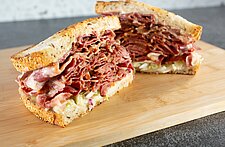By Chef Noah Michaels
Like most young American Chefs, “I studied French Cuisine” said Alex Harrell, Chef at Angeline in New Orleans. This statement is at the core of the culinary renaissance happening across America right now. In order to be taken seriously as a Chef, you had to know the classics, pumping out Dover Sole Meuniére and Tournedos Rossini in uptight French restaurants. While we became technically proficient, basting and flambéing with the best of them, we never really had any emotional or cultural connection with the food we were making. As Chefs, we put a lot of effort and emotion into everything we do but somehow for many of us mimicry felt a little soulless.
Like Chef Alex, other Chefs across the US realized that the food they were cooking had to mean something on a personal level. It had to reflect their heritage, where they grew up and the rich diversity of culture that makes up the states and cities in which they live. For many American Chefs, that meant retracing the rich agricultural, artisan and historical food heritage of the United States. Nowhere is this more evident than in the southeastern part of the country where Chefs are reviving their deep gastronomic heritage in new and exciting ways.
CLICK HERE to read my last article: Craft Hot Sauces Emerge with Monumental Growth
 The South, especially those Southern states from the original colonies, was the agricultural center of the original thirteen colonies, growing both a wide variety of native heirloom ingredients, but also specialty ingredients brought from Europe, Africa and Asia by settlers. This focus on agriculture and homesteading deeply influenced the larder of the Deep South. Focus on natural forms of preservation, including smoking, salting and pickling allowed Southerners the ability to enjoy the bounty of the South year round spawning famous dishes like Hoppin’ John; a stew of field peas stewed in pork stock with aromatics and smoked pork served over rice. It’s a very simple dish but its quality is directly related to the quality of the ingredients.
The South, especially those Southern states from the original colonies, was the agricultural center of the original thirteen colonies, growing both a wide variety of native heirloom ingredients, but also specialty ingredients brought from Europe, Africa and Asia by settlers. This focus on agriculture and homesteading deeply influenced the larder of the Deep South. Focus on natural forms of preservation, including smoking, salting and pickling allowed Southerners the ability to enjoy the bounty of the South year round spawning famous dishes like Hoppin’ John; a stew of field peas stewed in pork stock with aromatics and smoked pork served over rice. It’s a very simple dish but its quality is directly related to the quality of the ingredients.
As the industrial revolution came and went, it changed the nature of the South. The focus on agriculture fell by the wayside being replaced by factories and big agriculture. Somehow dishes like Hoppin’ John lost most of their magic as the ingredients were replaced with beans, bacon and rice from the grocery store. The focus on grains, beans and vegetables fell by the wayside, being replaced with the meat heavy cuisine of the mid twentieth century. People stopped considering Southern Food anything special or refined, relegating it to church picnics and fried chicken chains. While I love fried chicken as much as the next person, it’s hard to base a whole culinary culture on it.
For more chef inspired content, CLICK HERE to sign up for our weekly newsletter
 Fortunately for Southern Cuisine, several families and Chefs engaged in the practice of Seed Sharing, saving their families heritage ingredients from extinction. Thanks to their commitment to their agricultural past and the tireless work of an ex Pilot, Truck Driver, Boat Navigator, Restaurateur and Antebellum Scholar, Glenn Roberts, these ingredients survived. After realizing the depths that native Carolina ingredients had sunk to one night during a particularly rough service, where he and the staff spent much of the evening picking weevils out of Carolina Gold Rice, he realized the need to begin bringing these ingredients back in a meaningful but also loving way.
Fortunately for Southern Cuisine, several families and Chefs engaged in the practice of Seed Sharing, saving their families heritage ingredients from extinction. Thanks to their commitment to their agricultural past and the tireless work of an ex Pilot, Truck Driver, Boat Navigator, Restaurateur and Antebellum Scholar, Glenn Roberts, these ingredients survived. After realizing the depths that native Carolina ingredients had sunk to one night during a particularly rough service, where he and the staff spent much of the evening picking weevils out of Carolina Gold Rice, he realized the need to begin bringing these ingredients back in a meaningful but also loving way.
In 1995 he began the journey that would eventually lead to the formation of Anson Mills, one of the leading purveyors of Southern ingredients, by driving around South Carolina Plantations and fallow fields looking for seeds of Carolina mill corn. He was able to regrow the seeds he found, eventually leading to the reintroduction of Gourdseed grits. This ingredient helped to reinvigorate the Chefs of big cities such as Charleston and Atlanta to rediscover their heritage, putting Southern food back on the map. Through Chefs like Sean Brock and Authors such as the Lee Brothers, people started learning about the rich history and flavors of Southern food. Because of their work, a greater amount of the populace realized the importance to preserving this culture. The University of Mississippi center for the study of Southern culture founded the Southern Foodways Alliance “to document, study and explore the diverse food culture of the changing American South” in 2001. The Southern Revival was officially underway.
CLICK HERE to read Culinary Chronicles: The Rise of American Entomophagy
 As restaurants like McCrady’s gained notoriety, young chefs began to explore the Southern pantry, realizing their own gastronomic culture was something to be proud of. Either through working with these visionary Chefs or by bringing in parts of their own food culture, Southern food began to evolve again. Chefs like Andrew Ticer and Michael Hudman combined their Italian roots with their Southern roots to create dishes like Black Eyed Pea Torteloni with Ham Hock Brodo. Chef Ed Lee sees similarities between the culture of preservation in Korean and Southern cuisine and serves Kimchi and Collard Greens. Chef Asha Gomez takes her South Indian heritage and combines it with the culinary culture of Atlanta serving Fried Kerala Chicken with Waffles. All the while, Chefs like Sean Brock work to refine the dishes of his native Appalachia, finding new and exciting ways to proudly share his culture. This dynamic Culinary movement leaves us eagerly waiting to see what the next wave of the Southern Revival will look like.
As restaurants like McCrady’s gained notoriety, young chefs began to explore the Southern pantry, realizing their own gastronomic culture was something to be proud of. Either through working with these visionary Chefs or by bringing in parts of their own food culture, Southern food began to evolve again. Chefs like Andrew Ticer and Michael Hudman combined their Italian roots with their Southern roots to create dishes like Black Eyed Pea Torteloni with Ham Hock Brodo. Chef Ed Lee sees similarities between the culture of preservation in Korean and Southern cuisine and serves Kimchi and Collard Greens. Chef Asha Gomez takes her South Indian heritage and combines it with the culinary culture of Atlanta serving Fried Kerala Chicken with Waffles. All the while, Chefs like Sean Brock work to refine the dishes of his native Appalachia, finding new and exciting ways to proudly share his culture. This dynamic Culinary movement leaves us eagerly waiting to see what the next wave of the Southern Revival will look like.
Here's one of my favorite Southern recipes:
Hoppin’ John
1 quart Smoked Ham Stock, defatted and ham bits reserved
7 ounces (1 cup) Anson Mills Sea Island Red Peas, covered with water, soaked overnight in the refrigerator, and then drained
½ yellow onion, peeled, cut through root end, and layers left intact
½ carrot, peeled
2 small inner celery ribs, leaves attached
2 garlic cloves, peeled
1 small Turkish bay leaf
1 teaspoon curry powder
½ teaspoon red pepper flakes, or to taste
Fine sea salt
Bring the stock to a simmer over medium-high heat in heavy-bottomed 3-quart saucepan. Stir in the soaked and drained peas, the onion, carrot, celery, garlic, bay leaf, and curry powder. Return the liquid to a simmer, and then reduce the heat to low. Cover the pan partially and simmer gently, stirring occasionally, until the peas are tender, 1 to 1¼ hours.
Remove and discard the vegetables and bay leaf. Season with the red pepper flakes and salt to taste. Remove ¼ cup or so of peas and broth and puree them in a blender or food processor or with a burr mixer. Return the puree to the pot with the peas. (Alternatively, you can mash the peas directly in the pan with a potato masher or fork.) If the gravy is too thick, thin it with a bit of water. Stir in the reserved ham, if desired. Cook just until heated through. Taste for seasoning and serve hot over Simple Buttered Carolina Gold Rice Grits.
For more Southern Revival information, check out the links below:
SeriousEats.com - Southern Hoppin' Joe
NPR - Mississippi Masala: How A Native Of India Became A Southern Cooking Star




